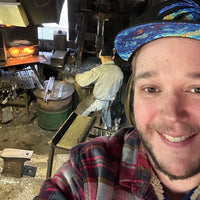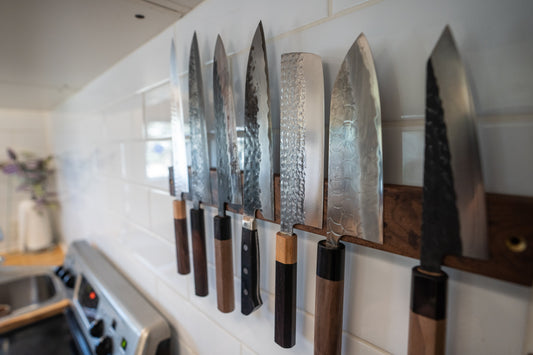The Top 5 Ways to Keep Your Kitchen Knives Sharp
Pop quiz, hot shot: What’s cheaper? Regular oil changes for your vehicle, or a new engine? Take your time, think it over, I’ll wait...

The unrelenting march of time; ambivalent to our musings and speculations of self, will unquestionably humble our proudest moments. Kings, gods, and monsters; laid low without a trace of discrimination, vitriol, or malice.
- Owen Whitinger
Correct. Preventative maintenance always wins - whether it be automotive work, dental procedures, keeping up with housekeeping, or even your knives - taking the recommended preventative measures will end up saving you time, money, and stress in the long run. So what should one do to take care of their precious steel babies? It’s really not that complicated. In fact, all the basics could be covered in a short and witty listicle. That’s right baby, this is the top five ways to keep your knife sharp LETS GOOOOOO!
1. Get a proper honing rod
This one is really important, and also one a lot of people get wrong. You’ve probably seen chefs and cooks on TV going HAAM on their knives with a steel rod. Everyone’s favourite toxic kitchen tyrant Gordon Ramsey really likes to show off his knife-blasting steel-rodding technique whenever he’s not too busy emotionally assaulting an unsuspecting, passionate, misguided, aspiring chef.
 Wow, he threw a knife at us!
Wow, he threw a knife at us!
This is not the way. Get yourself a ceramic rod. A ceramic rod is by a wide margin the easiest and most effective way to gently touch up your edge. Steel and diamond grit rods are really coarse and bitey. They remove an alarming amount of steel from your knife with each pass, and will whittle your precious blade into a knitting needle much faster than you might imagine. Ceramic rods, on the other hand, are much smoother and much harder. They do an incredible job at keeping your edge in good repair without removing copious amounts of steel. Think of a ceramic rod as a knife toothbrush. It’s not gonna fix a cavity, but it’s an essential tool if you wanna take good care of your blade/teeth. Also, they’re half price whenever you buy a knife. Not too shabby! Check out this article on how to use them.

2. Strop, strop, strop.
When I started working at Knifewear so many years ago, one of the first things I needed to learn was how to properly sharpen a knife. It’s a pretty important skill to have in this line of work. Not gonna lie, I was pretty anxious that I wouldn’t get the hang of it, I’d get fired, and I’d have to go back to working in a kitchen. As it turned out, it’s not really that difficult to pick up the basics and get some relatively good results with only a little bit of practice. Oddly enough, the thing I had to spend the most time working on actually had nothing to do with sharpening stones - it was stropping.
Stropping is extremely important if you want to get that “professional quality” edge. Most casual cooks will be perfectly happy with a ceramic rod, but if you really want to squeeze every last drop of performance out of your knives, you must strop. And strop. And strop. Every time I sharpened a knife and was happy with the edge, I would bring it to my boss for feedback. Without fail, every single time, I got the same response. “Good job. Keep Stropping”.

Stropping does three things. The first, and perhaps most important, is removing and smoothing out the wirey burr left on the edge after sharpening. Cleaning that burr is really important if you want your edge to glide in a satisfying fashion. Second, it’s an incredibly powerful maintenance tool. Imagine for a moment a steel knife and a ceramic rod contacting one another on a microscopic scale. It would look like two huge mountain ranges coming together, with only the peaks making clear contact. Because a strop is soft and supple, it really gets into those valleys and straightens out those really fine burrs, making your knife feel that much sharper.
Lastly, you’ll notice that my strop is green. Why is it green? It’s because we use a polishing compound called chromium oxide, or “KOYO”. We smear a bunch of this compound into the suede side of our strops. As the name suggests, polishing compounds helps make materials smooth and shiny, and a smooth edge cuts better.
Wire burr removal, microscopic burr correction, and polishing. It’s a triple threat! If a ceramic rod is a toothbrush, then a strop is… flossing? Mouthwash? A water pick? Whatever. It’s important. Get one.

3. Storing Your Knives Properly
This one is easy, and pretty self explanatory. Put your knife away like you care about it. There are heaps of options. Blade guards or sayas, wall mounted magnets (that DON’T have exposed metal or hard magnets on the surface), knife blocks & knife stands, or even the box it came in. Tossing a knife in your cutlery drawer is bad for the knife, the cutlery, and potentially your fingers. Check out this article to figure out which storage option is best for you!]

4. Use a good cutting board
This is a big one. Lots of pitfalls. Basically, if you slice into your cutting board and feel the edge of the blade sink in slightly, you’re in good shape. Our favourite materials are wood (preferably end grain, but side grain is usually fine too), and easy to clean plastics like those from Hasagawa. Wooden boards and properly made plastic boards are not only better for the edge of the knife, but are also much easier to keep clean and sanitary. A lot of commercial plastic cutting boards you’ll find at most kitchen supply stores are perfectly fine for the edge, but are actually kinda hard to clean. The little gashes the knife creates can be really difficult to scrub out - have you ever chopped a bunch of parsley on a white plastic cutting board? That big green stain it leaves? Yeah, not super appetising. Wooden boards, if properly maintained with board wax, will naturally close those gaps on their own and will push out nasty stuff. Again, preventative maintenance comes into play here - just like honing your knife with a ceramic and a strop, waxing or oiling your wooden cutting board will save headaches in the future.
Hasegawa boards are a bit more science-y. They are impregnated with ionised silver - completely safe for human consumption, but “deactivates” bacteria on the board and prevents it from growing. I stress this distinction - it does not kill the bacteria! It just prevents growth and spreading. You still need to wash it like normal! Don’t be gross!
Materials to avoid? Glass. Bamboo. Hard composite materials. The countertop. Lacquered wood. Those are really hard and will dull a knife pretty fast. You also want to avoid spalted woods - decorative woods coloured by fungus. They’re really pretty and make for great guitars or coffee tables when lacquered, but you definitely don’t want to cut up food on them!

5. Sharpen your knife by hand
So you’re following all these guidelines. Nice work! I bet your knife is in great shape and appreciates your efforts. You get a gold star!
However, try as you might to be a great knife guardian, nothing stays sharp forever. No amount of stropping or honing or care or love will ensure that your knife won’t ever need sharpening! Sharpening, unlike honing, implies that you’re actually reshaping the knife’s geometry to form a nice, shiny, keen edge. There are a staggering variety of methods by which one can sharpen a knife, and a vast variety of convenience tools to make the task easier. But, after years and years of experience, I can say with a great deal of confidence that there is absolutely no replacement for hand-sharpening performed by someone who knows what they’re doing. Pull through sharpeners, angle guided gizmos, knife clips, all of these tools can work in a pinch - but at the end of the day, they’re not actually addressing the problem at its source. They’re just going to act as a quick band-aid - and if overused, they can really turn around and bite you in the butt!
If you don't want to spend a bunch of time learning how to sharpen, just bring us your knife or mail it in. We’ll sharpen it up for you! We do an amazing job. We do it quickly. We do it for pretty cheap. And we even donate half of all our sharpening proceeds to charity. Everybody wins!
Curious to learn more? Great! Check out our sharpening videos on YouTube or consider taking one of our sharpening classes, and snag yourself a set of sharpening stones! We’ll get you started down the right path.
So is that it? Are those the only things you need to do to make sure your knife stays in good shape? Well, it’s a good start. I’m reminded of a really interesting bit performed on “Top Gear”, a show about three British car dudes doing very silly things. They brought two cars to a racetrack - one, a Toyota Prius. A car designed to be fuel efficient and practical. The other, a BMW M3. A car designed to be exciting - high performance, fancy engineering, and really fast. The test was simple - both cars were given one gallon of gas. The Prius was driven around the track at its maximum performance. A real professional race driver trying to squeeze every last drop of speed out of this vehicle designed for daily commutes and trips to the grocery store. The driver of the M3 followed it. It stalked the Prius around the track like a lioness following a big tasty wildebeest, keeping just within reach, but never overtaking its prey. Which vehicle ran out of gas first? The inefficient sports car being driven cautiously, or the thrifty daily driver being driven like a maniac? Honestly, I can’t say I was surprised when the Toyota tapped out first. It’s not necessarily what you drive, it’s how you drive it.
So please - for your sake, your knife’s sake, and for me, the poor schlub who will fix it when it gets damaged - drive safe! Check out some of our YouTube content about how to properly use your knife, because proper usage is really the most important thing of all!
Stay sharp!














